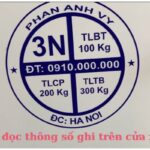Trucks, indispensable partners in freight transport, are complex machines with numerous parts. Understanding these parts is crucial for effective communication with mechanics, better vehicle maintenance, and overall knowledge enhancement. This detailed guide from Xe Tải Mỹ Đình will familiarize you with these specialized terms easily.
Exploring the World of Truck Parts
A truck comprises thousands of large and small parts, each with a specific function, working harmoniously for smooth operation. We can categorize these parts for easier understanding:
1. Truck Cabin – The Driver’s “Mobile Home”
The cabin is not just the driver’s workplace but also a “mobile home” on long journeys. Key components include:
- Steering Wheel: Controls the vehicle’s direction. Modern steering wheels integrate controls for horn, lights, audio, and cruise control.
 steering wheel with integrated controls
steering wheel with integrated controls - Dashboard (Instrument Panel): Displays crucial information (speed, RPM, fuel level, engine temperature…) and houses controls for lights, air conditioning, wipers, and entertainment systems.
 truck dashboard showing gauges and controls
truck dashboard showing gauges and controls - Seats: Ensure comfort for the driver and passengers throughout the journey. Truck seats are designed to minimize vibration and provide back support.
 comfortable truck seat with back support
comfortable truck seat with back support - Gear Shift Lever: Controls the transmission, allowing the driver to select gears suitable for speed and terrain.
- Accelerator, Brake, and Clutch Pedals: Control speed, deceleration/stopping, and disconnect/connect engine power to the wheels (for manual transmissions).
- Rearview Mirrors: Help the driver observe the rear and sides of the vehicle, ensuring safety during maneuvering and lane changes.
 truck rearview mirror providing wide view
truck rearview mirror providing wide view - Air Conditioning System: Creates a cool, comfortable cabin environment, especially important in hot weather.
- Entertainment System: Radio, speakers, and entertainment screens help drivers relax and reduce stress.
2. Truck Chassis – The “Backbone” of the Entire Vehicle
The chassis is the foundation, bearing the main load and housing all other vehicle parts. Key components include:
- Frame (Chassis): The main load-bearing beam system, usually made of high-strength steel, ensures the vehicle’s robustness and load capacity.
- Suspension System: Reduces shock and vibration from the road to the frame and cabin, providing a smoother ride and protecting cargo. Common suspension types include leaf spring, air suspension, and coil spring.
- Axles and Differentials: Transmit power from the engine to the wheels and bear the vehicle’s load. Trucks can have one or more axles depending on the load and design. Differentials can be driven (transmitting power) or passive (bearing load only).
- Steering System: Includes the steering wheel, steering shaft, steering gear, and linkage mechanisms, helping the driver control the vehicle’s direction.
- Braking System: Ensures safe operation, helping the vehicle decelerate and stop. Truck braking systems are typically drum brakes or disc brakes, combined with ABS and EBD for enhanced effectiveness and safety.
- Wheels and Tires: Directly contact the road surface, bear the load, and ensure the vehicle’s mobility. Truck tires are specially designed to withstand heavy loads and operate in harsh conditions.
3. Truck Engine – The “Heart” of Power
The engine is the power source for the truck, converting chemical energy from fuel into mechanical energy for movement. Key engine components include:
- Engine Block and Cylinder Head: Enclose and protect the internal engine components.
- Pistons and Cylinders: Where fuel combustion and power generation occur.
- Crankshaft and Connecting Rods: Convert the piston’s linear motion into rotary motion, generating power.
- Fuel System: Supplies fuel (diesel or gasoline) to the engine, including the fuel tank, fuel pump, fuel injectors, and fuel lines.
- Cooling System: Maintains a stable operating temperature for the engine, preventing overheating and damage. Typically uses coolant or specialized cooling fluid.
- Lubrication System: Reduces friction between moving parts in the engine, prolonging lifespan and ensuring smooth operation. Uses engine oil.
- Exhaust System: Discharges exhaust gases into the environment after fuel combustion. Modern exhaust systems often integrate exhaust filters to minimize pollution.
- Engine Electrical System: Provides power for starting systems, ignition (for gasoline engines), and engine control sensors.
4. Truck Bed – The Versatile “Cargo Space”
The truck bed is the cargo-carrying compartment, available in various styles and sizes depending on the intended use and type of cargo. Some common types include:
- Flatbed: Open-top bed, often used for transporting building materials and bulky goods.
 truck flatbed carrying lumber
truck flatbed carrying lumber - Enclosed Bed (Van Body): Bed with a roof and enclosed walls, protecting cargo from weather and dust, suitable for transporting dry goods, electronics, and food.
 truck van body protecting cargo
truck van body protecting cargo - Tarpaulin Bed (Curtain Side): Bed with a frame and covered with a tarpaulin, flexible for carrying goods and easy to load/unload.
- Refrigerated Bed: Insulated bed with a cooling system, specialized for transporting temperature-sensitive goods such as fresh food and medicine.
 refrigerated truck transporting produce
refrigerated truck transporting produce - Dump Bed: Bed with a lifting mechanism, allowing for quick unloading of cargo, commonly used in construction and mining.
5. Electrical System – The Truck’s “Nervous System”
The electrical system on a truck acts as a “nervous system,” providing power and controlling various systems on the vehicle. Key components include:
- Battery: The main power source for the vehicle when the engine is not running or when power demand exceeds the generator’s capacity.
- Alternator (Generator): Generates electrical power when the engine is running, providing power to systems and recharging the battery.
- Wiring Harness: The network of wires that transmits power to various components on the vehicle.
- Lighting System: Headlights, turn signals, taillights, fog lights… ensure visibility and signaling in low-light conditions and adverse weather.
- Horn: Signals to people and other vehicles when necessary.
- Starting System: Starter and related circuits help start the engine.
- Electronic Control Unit (ECU): The brain that controls electronic systems on the vehicle, including engine control, transmission, ABS, and many other systems.
Conclusion
Understanding the names and functions of truck parts not only helps you feel more confident when using and maintaining your vehicle but also helps you communicate more effectively with repair professionals when needed. This article from Xe Tải Mỹ Đình hopes to have provided you with an overview and easy-to-understand guide to the world of truck parts. If you have any questions or need advice on trucks, don’t hesitate to contact us!

